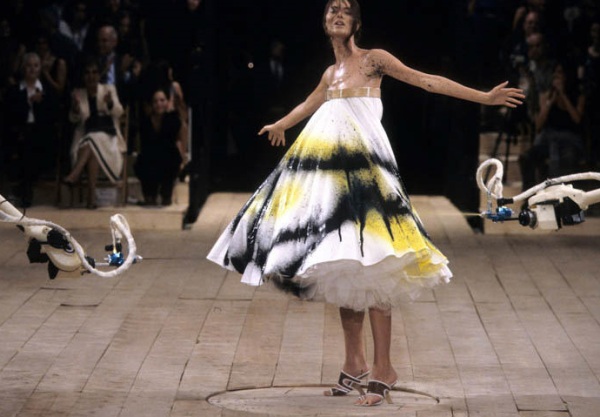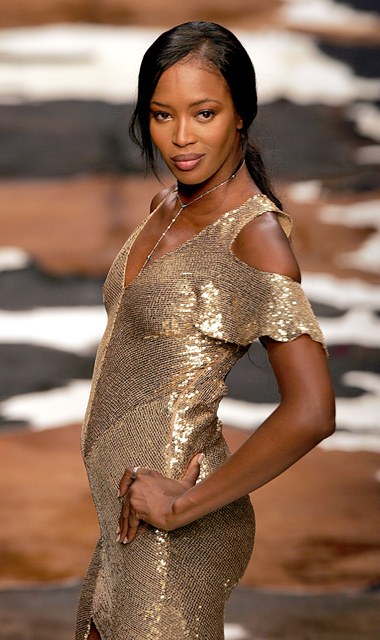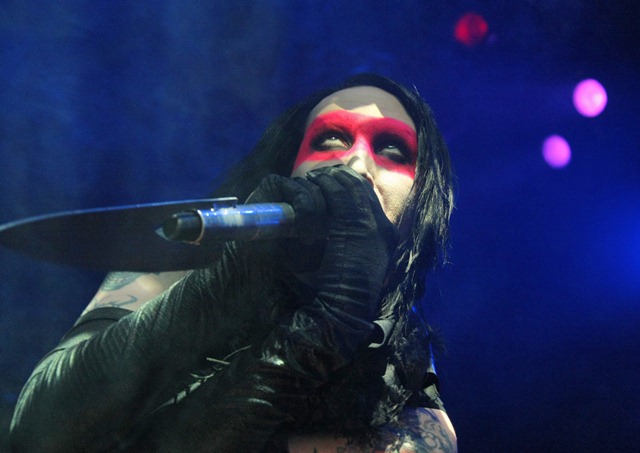History of Fashion 1990s – 2000s
History of Fashion 1990s – 2000s
‘There’s going to be a big change in the nineties and it’s only just beginning. The eighties were a very conservative period, sexually and in so many ways. There’s a restructuring of priorities. It’s less about flash and more about people in the streets, the environment. People are becoming more real.’
Calvin Klein

Alexander McQueen – Spring-Summer 1999
The Nineties
Fashion houses played musical chairs, the loud garish power styles declined making room for the office cardigan and the deaths of Diana and Gianni Versace shocked the world. The nineties took influence from the sixties and seventies styles and a new laidback style materialized.
Arts and Culture
Britain saw a fashion renaissance with the graduation of Alexander McQueen in 1992. His graduating collection was spotted by Vogue stylist Isabella Blow which led onto his first appearance in Vogue in November the same year. Britain was in the fashion spotlight again as John Galliano made fashion history by being appointed head of French couture house Givenchy, a crucial moment for Paris couture.
When Gianfranco Ferré left Christian Dior, Galliano replaced him. With this an upheaval happened in the fashion world; Alexander McQueen went to Givenchy, Michael Kors went to Celine, Stella McCartney took over at Chloé, Marc Jacobs moved to Louis Vuitton and Alber Elbaz went to Guy Laroche and then onto Yves Saint Laurent, head of the ready to wear collections while Laurent concentrated on the couture. The Nineties saw the public wanting to buy into the lifestyles the designer brands perceived, they wanted the perfumes, makeup and clothes of the designer. Designers Dries Van Noten, Martin Margiela and Ann Demeulemeester encompassed a new brand of designers helping Belgium being taking seriously for fashion.
Peruvian photographer Mario Testino bought the end of the ‘uber’ model during the nineties. Refusing to pay the expensive prices of Linda Evangelista, Cindy Crawford, Naomi Campbell at all, Testino chose a new pool of models including Kate Moss. Known for taking the famous Vanity Fair cover shots of Princess Dianna, he saw a wealth of success during the nineties and following years from the fresh, glamorous reality of his photographs.

Copyright © AFP / Jagmohan Ghatora / Eyepress
With the rise of films The Oscars were seen as an excellent place for designers to showcase their work. This led to the Oscar fashions being directly copied from the red carpet to the High Street stores of America. Nicole Kidman and Tom Cruise were seen on the red carpet in 1991 in a short black sequined dress and an oversized tux. Sharon Stone wore aVera Wang ball skirt in 1999 but teamed it with a white shirt from Gap that she borrowed from her husband’s wardrobe. Other memorable dresses included Kim Basinger at the 1990 Oscars in a meringue style princess dress covered up with a long sleeved jacket. Designed by her, the dress was not seen as Oscar worthy. Elizabeth Hurley was seen at the premiere of “Four Weddings and a Funeral” in 1994 dressed in a Versace silk crepe dress kept together with large gold safety pins.
The nineties saw an increase in the rave culture with England, Germany and America creating a new scene of dance music, drug taking and new fashions. The rave culture had their own uniform of neon colours, glow sticks, short skirts, crop tops and very little clothing being worn.
American TV sitcoms like Friends became increasingly popular. The programme inspired fashion trends and hairstyles, most notably ‘The Rachel’ hair style. The iconic show Sex in The City began in 1998 bringing with it a whole world of Jimmy Choo’s, Manolo Blahnik and Louboutin’s.
Shapes and Silhouettes
The first 1990 cover of Vogue appeared the ‘uber’ models of Naomi Campbell, Linda Evangelista, Tatjana Patitz, Christy Turlington, and Cindy Crawford smiling in minimal makeup and faded jeans. Gone were the eighties sharp shoulders and escalated hair and in came a more relaxed casual style. There was a revival of sixties and seventies styles with the flared trouser reappearing – eventually becoming known as the bootleg trouser and platform shoes having resurgence. Stretch leggings replaced the tailored sharp trousers with Pucci prints being a must have trend. The long skirt took over globally creating more elegant silhouettes.
Designer Issey Miyake had been working on new methods of pleating since the late eighties which resulted in a new technique called garment pleating in 1993. The garments were cut and sewn first then placed between layers of paper and put through a heat press where they were pleated. The pleats help when the paper was removed and were ready to wear. Alexander McQueen reworked the low waist trousers seen in the sixties and seventies in his 1996 show “Dante” modelled by Kate Moss. Critics pointed out the bumsters were similar to what you would see on a building site. The lowest styles seen by McQueen weren’t worn, however slightly hire bumsters were worn.
Following with the trouser trend, Italian company Diesel reached global domination in the nineties with its presence in forty countries. From the direction of Wilbert Das, Diesel opened its first flagship store in New York and along with an advertorial campaign of social and political commentary mixed with black humour, Diesel jeans began to dominate.
1993 saw a new subculture – grunge. Starting in Seattle, USA, the grunge subculture stemmed from the style of music of Nirvana and Pearl Jam. Flannel, plaid shirts were worn with band t-shirts, hats, jeans and converse shoes. Hair was worn long and a general unkempt look was needed. Along with the grunge style, punk saw a revival in New York, Milan and Paris with bondage short skirt, safety pins, kilts and raw textures being seen by designers Yohji Yamamoto, Chanel, Gianni Versace and Thierry Mugler.
![Kurt Cobain About A Son (2006) Pers: Kurt Cobain Dir: Aj Schnrack Ref: KUR006AA Photo Credit: [ Bonfire Films/Sidetrack Films / The Kobal Collection ] Editorial use only related to cinema, television and personalities. Not for cover use, advertising or fictional works without specific prior agreement History of Fashion 1990's - 2000's](/wp-content/uploads/2012/08/catwalk_yourself_kurt_cobain.jpg)
Copyright © AFP / Bonfire Films / Sidetrack Films / The Kobal Collection – Kurt Cobain / About a son (2006)
Everyday fashion throughout the decade saw high waist jeans and t-shirts tucked in, oversized sweaters and black opaque tights worn with dresses or white socks and trainers. Floral dresses, blouses, turtleneck tops were worn by taking inspiration from the sixties and seventies. Designer labels were now quietly on show, displaying chic and elegance.
Accessories
The Prada nylon bag and Fendi Baguette bag were must have accessories during the nineties. Doc Martens were popular again especially with the grunge style. Head bands and scrunchies were seen for everyday fashion as were backpack handbags. A minimal style of hair and jewellery filtered in a complete opposite from the eighties styles.
Menswear
The pop rock style was popular with men during the nineties e.g., Converse All Star trainers, straight legged trousers, black leather jackets and sheepskin coats. Addidas trainers and aviator sunglasses were also part of the rock pop look. Neon coloured trainers, baseball jerseys and graphic print T-shirts were worn by men while in America hip hop fashion went mainstream with gold jewellery, baggy jeans, tracksuits and bomber jackets being an accepted style. A smart-casual trend was well liked with khaki slacks, blazers and shirts that were worn un-tucked.
The Icons
Princess Diana was still a major icon and fashion influence, now not under the restrictions of the royal family; she was able to wear other designers, shorter skirts and heels. The ‘uber’ super models were still iconic with Linda Evangelista, Cindy Crawford, Naomi Campbell and Christy Turlington household names. Gwyneth Paltrow, Julia Roberts and Jennifer Aniston were the icons of film and T.V, portraying the casual nineties looks. New model Kate Moss started out was popularized via the heroin chic look while Marylin Manson and Kurt Cobain were the male trend setters.

Copyright © AFP / RIA Novosti
Designers
Gianni Versace
Gianni Versace was shot dead on July 15th 1997 aged only 50. Openly shot on the steps of his Miami Beach mansion, the founder of Versace died. Gianni’s sister Donatella took over the company and became the new head of design. After her first couture collection for Versace, Donatella talked about refining the full blown Versace glamour and diluting it.
Alexander McQueen
Iconic designer Alexander McQueen started out in Saville Row and after working for Koji Tatsuno and Romeo Gigli he applied to work as a pattern cutter tutor at Central Saint Martins. Due to the strength of his portfolio he was enrolled at the college as a student. After graduating from Saint Martins in 1992, McQueen was spotted by Isabella Blow and was featured in British Vogue the same year. McQueen developed the low waist trouser which was also known as ‘bumsters’ which were a popular fashion during the nineties. McQueen was appointed as chief designer at Givenchy succeedingJohn Galliano. In 1998 he caused controversy when Aimee Mullins a double amputee and former Para Olympian modelled in his show wearing a pair of hand carved wooden prosthetic legs. This showed that it was now standard to expect the unexpected with Alexander McQueen.
Junya Watanabe
A Japanese fashion designer who was the protégé of Comme des Garçons designer Rei Kawakubo, Junya Watanabe is known for his simple and pure line aesthetic. After graduating from Tokyo’s Bunka Fashion College Watanabe became an apprentice at Comme des Garçons as a patternmaker. After various promotions he started to design for the Homme line. Following this he started to work under his own name for the company in 1992. He began showing his Junya Watanabe Comme des Garçons collection in Paris in 1993.
Martin Margiela
The designer’s fashion that is often seen as art started when assisting Jean Paul Gaultier. The Belgium designer made deconstruction a fashion term via his use of destroying and recreating garments. Known for recycling old clothes and materials he was also unconventional with his shows – showing in a cemetery and fire station. In 1997 Margiela was appointed to design Hermes ready-to-wear-collection, completely reinvigorating the label. In 1999 along with Karl Lagerfeld, Jean Paul Gaultier and Thierry Mugler, Margiela designed for French catalogue 3Suisses.
Catwalk Shows
Vivienne Westwood
Westwood’s 1993 collection Anglomania contained tartan, suiting, high shoes and checked patterns. The high shoes were what made most of an impact, with the Super Elevated Gillie platform shoes. The breathtakingly high platforms were worn by Naomi Campbell who famously fell during the fashion show.
Alexander McQueen
Known for his dramatic clothing, McQueen started to be noticed for his theatrical catwalk shows. Apart from McQueen sending Aimee Mullins down the runway in 1998, he had previously shown models walking through water in 1997 and 1999 showed the couture collection featuring a spray painting robot.
History of Fashion 1990s – 2000s


Not the biggest thing in the world… but the photo of Manson is from around 2012. Manson in the 90’s looked a lot different.
nice
Loved it!!!!! <3
Nice
cool